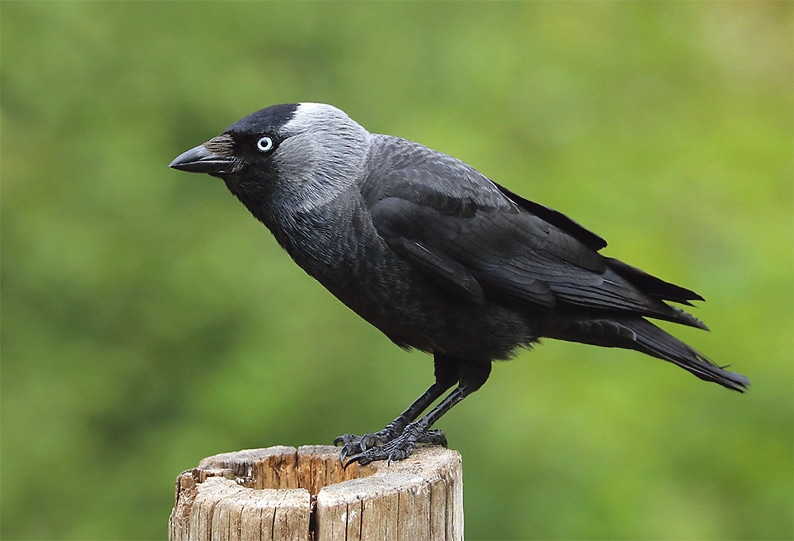
Jackdaw 
Rook
by Nicholas Mitchell
‘The rook and jackdaw are too well known to need any introduction in themselves, as one need not go far from the centre of the city before seeing one or both species. On the principle that familiarity breeds contempt, it is perhaps their very abundance which accounts for our incomplete knowledge of them, in fact as I have frequently learnt to my cost.’
Edgar Harper,
A Study of Rooks, 1904
The star of the show when it comes to winter roosting birds is the starling. The breathtaking beauty of a murmuration is a wonder, as the starlings move as if one large shape-shifting organism in the darkening dusk sky, before pouring into their roost like liquid treacle. However, that is not the only show in town; rooks and jackdaws also have their winter rituals before going to roost at dusk, but to see it, you need to ‘follow the rooks’.
The Rook (Corvus frugilegus, Rúcach) favours agricultural country, both arable and more importantly grassland, and tends to avoid heavily wooded country, so is abundant in West Cork. During autumn and winter they gather in large numbers at dusk before spending the night in tree roosts, often with the Jackdaw (Corvus monedula, Cág), another common bird here. They are both members of the Corvid (Crow) family that also includes Raven, Hooded Crow, Chough, Magpie and Jay.
Rooks and jackdaws do not go directly to their roost site, but gather first in fields and nearby bare trees. The great gathering starts shortly after sundown as the birds fly in from different directions after a day’s foraging. The air is filled with the ‘caws’ of rooks, punctuated by the canine-like yapping of the jackdaws. The steady pattern of their flight is broken by individuals wheeling away into wild tumbling flights. This is known as whiffling. Wading birds like lapwing do something similar; it is thought as defence against possible predators. In flight rooks and jackdaws can be told apart by their size and shape, the rook being about one-third larger than the jackdaw and having more of a rounded wedge shaped tail.
In order to find out where these birds will roost for the night, the first job is to find where they gather, and then watch and wait. As the skies darken, the cries and chattering blend into a more harmonious chorus, and the birds become ink black shapes and harder to distinguish. Then it happens, slowly at first, as a small group of birds take to the air, and then another group, and another. Soon, in the gloom, there can be seen a swirling stream of birds, all flying in the same direction towards their final roost, leaving behind empty fields and trees. It is a sight and sound to behold, but to find their roost, you will need either a good vantage point or to follow them.
Generally, the roosts are in either conifer woods or mixed woodland. But why do they roost in such large numbers? Possibly it is for protection from bad weather or low temperatures, but they would be more likely to roost solely in conifers if that were so. Also, rooks and jackdaws spend the night in pairs and not huddled together like some other bird species such as Long-tailed Tits. One theory is that the roost acts as a sort of information centre and observations and experiments certainly support this. At Newborough Warren, a large raven roost on Anglesey, biologists Wright, Stone and Brown demonstrated, with the use of sheep carcasses and coloured beads, that information about the location of food is shared at the roost. Circumstantial evidence suggests that rooks and jackdaws do the same. There is a direct correlation between the size of the roost and the number of hours of daylight. During December and January there is a maximum of eight hours to find food that will sustain the birds during the night. On dull days this will be less. It is at that time of year, when the need to find food is at its greatest, that the number of birds in a roost is also at its largest.
If you want to enjoy one of nature’s lesser known spectacles then ‘follow the rooks’ one evening. If you happen to live near Clonakilty then White’s Marsh is a good place to start. In the meantime, the Branch is continuing to run outings. Our next event should be the West Cork Bird Race. At the time of going to press, it is unlikely that this will take place in its normal format, but we hope to do something. To receive up to date news about this and other events and, given the current situation, cancellations, join our mailing list (details below).
BirdWatch Ireland
West Cork Branch
For more information about the Branch contact
Nicholas Mitchell at secretary@birdwatchirelandwestcork.ie or join our mailing list by sending an email to mailinglist@birdwatchirelandwestcork.ie.


